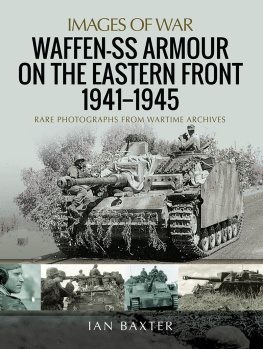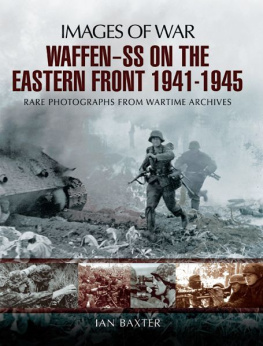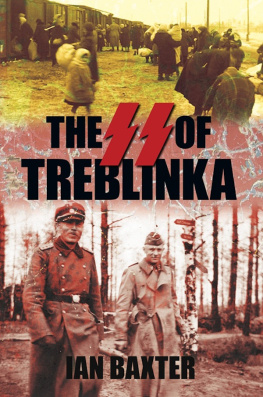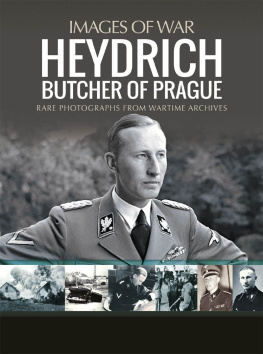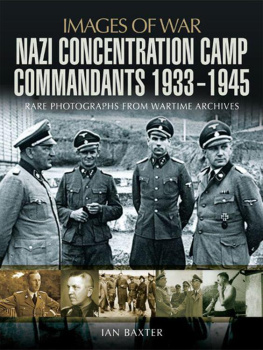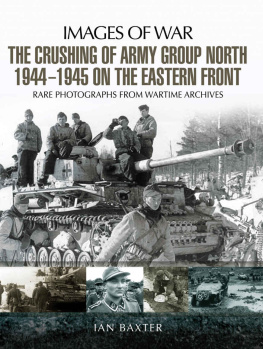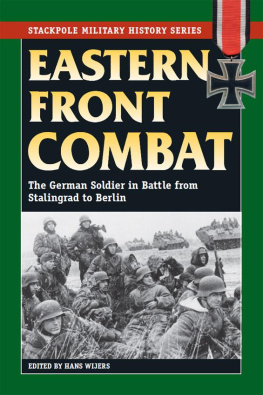Ian Baxter - German Army on the Eastern Front—The Advance
Here you can read online Ian Baxter - German Army on the Eastern Front—The Advance full text of the book (entire story) in english for free. Download pdf and epub, get meaning, cover and reviews about this ebook. year: 2015, publisher: Pen & Sword Books, genre: Non-fiction. Description of the work, (preface) as well as reviews are available. Best literature library LitArk.com created for fans of good reading and offers a wide selection of genres:
Romance novel
Science fiction
Adventure
Detective
Science
History
Home and family
Prose
Art
Politics
Computer
Non-fiction
Religion
Business
Children
Humor
Choose a favorite category and find really read worthwhile books. Enjoy immersion in the world of imagination, feel the emotions of the characters or learn something new for yourself, make an fascinating discovery.
- Book:German Army on the Eastern Front—The Advance
- Author:
- Publisher:Pen & Sword Books
- Genre:
- Year:2015
- Rating:4 / 5
- Favourites:Add to favourites
- Your mark:
- 80
- 1
- 2
- 3
- 4
- 5
German Army on the Eastern Front—The Advance: summary, description and annotation
We offer to read an annotation, description, summary or preface (depends on what the author of the book "German Army on the Eastern Front—The Advance" wrote himself). If you haven't found the necessary information about the book — write in the comments, we will try to find it.
German Army on the Eastern Front—The Advance — read online for free the complete book (whole text) full work
Below is the text of the book, divided by pages. System saving the place of the last page read, allows you to conveniently read the book "German Army on the Eastern Front—The Advance" online for free, without having to search again every time where you left off. Put a bookmark, and you can go to the page where you finished reading at any time.
Font size:
Interval:
Bookmark:


First published in Great Britain in 2015 by
PEN & SWORD MILITARY
An imprint of
Pen & Sword Books Ltd
47 Church Street
Barnsley
South Yorkshire
S70 2AS
Copyright Ian Baxter, 2015
ISBN 978-1-47382-266-5
eISBN 9781473852792
The right of Ian Baxter to be identified as author of this work has been asserted by him in accordance with the Copyright, Designs and Patents Act 1988.
A CIP catalogue record for this book is available from the British Library.
All rights reserved. No part of this book may be reproduced or transmitted in any form or by any means, electronic or mechanical including photocopying, recording or by any information storage and retrieval system, without permission from the Publisher in writing.
Typeset by Concept, Huddersfield, West Yorkshire HD4 5JL.
Printed and bound in England by CPI Group (UK) Ltd, Croydon CR0 4YY.
Pen & Sword Books Ltd incorporates the imprints of Pen & Sword Archaeology, Atlas, Aviation, Battleground, Discovery, Family History, History, Maritime, Military, Naval, Politics, Railways, Select, Social History, Transport, True Crime, and Claymore Press, Frontline Books, Leo Cooper, Praetorian Press, Remember When, Seaforth Publishing and Wharncliffe.
For a complete list of Pen & Sword titles please contact
PEN & SWORD BOOKS LIMITED
47 Church Street, Barnsley, South Yorkshire, S70 2AS, England
E-mail: enquiries@pen-and-sword.co.uk
Website: www.pen-and-sword.co.uk
About the Author
Ian Baxter is a military historian who specialises in German twentieth-century military history. He has written more than forty books including Poland The Eighteen Day Victory March, Panzers in North Africa, The Ardennes Offensive, The Western Campaign, The 12th SS Panzer-Division Hitlerjugend, The Waffen-SS on the Western Front, The Waffen-SS on the Eastern Front, The Red Army at Stalingrad, Elite German Forces of World War II , Armoured Warfare , German Tanks of War , Blitzkrieg , Panzer-Divisions at War, Hitlers Panzers, German Armoured Vehicles of World War Two, Last Two Years of the Waffen-SS at War, German Soldier Uniforms and Insignia, German Guns of the Third Reich, Defeat to Retreat: The Last Years of the German Army at War 19431945, Operation Bagration the destruction of Army Group Centre, German Guns of the Third Reich, Rommel and the Afrika Korps, U-Boat War, and most recently The Sixth Army, the Road to Stalingrad, German Mountain Troops, and Himmlers Nazi Concentration Camp Guards. He has also written over 100 articles including Last Days of Hitler, Wolfs Lair, Story of the V1 and V2 Rocket Programme, Secret Aircraft of World War Two, Rommel At Tobruk, Hitlers War with his Generals, Secret British Plans to Assassinate Hitler, SS At Arnhem, Hitlerjugend, Battle Of Caen 1944, Gebirgsjger at War, Panzer Crews, Hitlerjugend Guerrillas, Last Battles in the East, Battle of Berlin and many more. He has also reviewed numerous military studies for publication, supplied thousands of photographs and important documents to various publishers and film production companies worldwide, and lectures to various schools, colleges and universities throughout the United Kingdom and Southern Ireland.
Chapter One
Advance to the East
F or the invasion of Russia, code-named Barbarossa, the German Army assembled some 3 million men, divided into a total of 105 infantry divisions and 32 Panzer divisions. There were 3,332 tanks, over 7,000 artillery pieces, 60,000 motor vehicles and 625,000 horses. This massive force was distributed into three German Army groups:
- Heeresgruppe Nord commanded by Generalfeldmarschall Wilhelm Ritter von Leeb, which provided the main spearhead for the advance on Leningrad and assembled in East Prussia on the Lithuanian frontier.
- Heeresgruppe Mitte commanded by Generalfeldmarschall Fedor von Bock, which assembled on the 1939 Polish/Russian Frontier, both north and south of Warsaw. Bocks force consisted of forty-two Infantry Divisions of the 4th and 9th Armies, and Panzergruppen II and III. This army contained the largest number of German infantry and Panzer divisions in all three army groups.
- Army Group Sd commanded by Generalfeldmarschall Gerd von Rundstedt, which was deployed down the longest stretch of border with Russia.
The front, reaching from central Poland to the Black Sea, was held by one Panzergruppe, three German and two Rumanian armies, plus a Hungarian motorized corps, under German command.
During the early morning of 22 June 1941, the German Army finally unleashed the maelstrom that was Barbarossa. Both the Infantry and Panzer Divisions wasted no time and soon sliced through the bewildered Russian forces on every front. The ferocity and effectiveness of both the Infantry and Panzer Divisions were so great that groups of up to fifteen Russia divisions were trapped at a time and slowly and systematically annihilated in a hurricane of fire.
In the North, Leebs rapid two-pronged offensive along the Baltic opened up at first light on the morning of 22 June 1941. His force, consisting of 16th and 18th Armies, smashed through the Soviet defences. Russian soldiers stood helpless in its path, too shocked to take action. Over the next weeks to come, German troops of Heeresgruppe Nord continued to chew through enemy positions heading through Lithuania, Latvia and Estonia, straight towards their objective Leningrad. Fortunately for Leeb, the earth was baked under the blistering summer heat and his army was able to advance rapidly through the Baltic states.
By 10 July, Leebs units broke south of Pskov and rolled towards Luga. At the rate they were advancing, they would need no more than nine or ten days to reach the outskirts of Leningrad. But following their surge of success, the Wehrmacht were losing momentum. Not only were their supply lines being overstretched, but enemy resistance began to stiffen on the road to Leningrad. In a desperate attempt to blunt the German advance and prevent them from reaching the imperial city, brigades of Russian marines, naval units, and more than 80,000 men from the Baltic Fleet were hastily sent into action against Leebs forces. These Russian soldiers were now the sole barrier between Leningrad and the Germans. Although the advance was hampered by these Russian forces, by the end of August 1941, Leebs Panzers were finally within sight of Leningrad. The terrified civilians left inside the city walls were now going to endure one of the most brutal sieges in twentieth-century history.
As the summer of 1941 passed and the Germans drew closer to the city gates, Leningraders were given the grim orders to defend their city to the death. Although Leebs forces had arrived within shelling distance of Leningrad, the advance had not gone as planned. Already units had been badly disrupted and were mired on the Leningrad Front by stiffening resistance.
By 17 September, the Moscow Front could wait no longer for victory in the north. The shift of the main weight, the powerful 41.Panzerkorps which Leeb required to sledge-hammer his way to the outskirts of Leningrad, was taken out of line and ordered to the Moscow Front. Without the 41.Panzerkorps the whole dynamics of Heeresgruppe Nord had altered. There would now be no attack on Leningrad. Instead, Hitler ordered that the city would be encircled and the inhabitants defending inside would be starved to death. During October and November 1941, some ten German divisions were tied down around the city. For the next year German troops of Heeresgruppe Nord fought a series of bloody battles to hold their positions around Leningrad. Although they had managed to blunt Russian penetrations through their lines with the sacrifice of thousands of men killed and wounded, the battle had in fact absorbed all the available resources of the 18.Army and elements of the 11.Army, which had resulted in the planned assault on Leningrad being abandoned.
Next pageFont size:
Interval:
Bookmark:
Similar books «German Army on the Eastern Front—The Advance»
Look at similar books to German Army on the Eastern Front—The Advance. We have selected literature similar in name and meaning in the hope of providing readers with more options to find new, interesting, not yet read works.
Discussion, reviews of the book German Army on the Eastern Front—The Advance and just readers' own opinions. Leave your comments, write what you think about the work, its meaning or the main characters. Specify what exactly you liked and what you didn't like, and why you think so.


